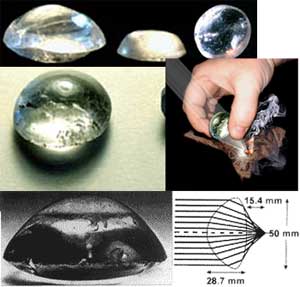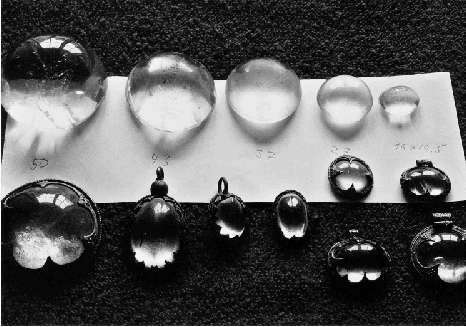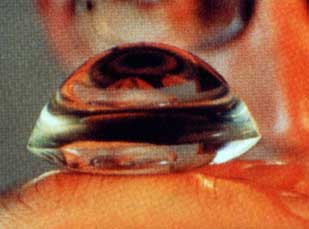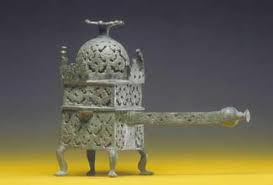It looks like you're using an Ad Blocker.
Please white-list or disable AboveTopSecret.com in your ad-blocking tool.
Thank you.
Some features of ATS will be disabled while you continue to use an ad-blocker.
share:

More than a century after its discovery in a ninth century woman’s grave, an engraved ring has revealed evidence of close contacts between Viking Age Scandinavians and the Islamic world.
Excavators of a Viking trading center in Sweden called Birka recovered the silver ring in the late 1800s. Until now, it was thought that it featured a violet amethyst engraved with Arabic-looking characters. But closer inspection with a scanning electron microscope revealed that the presumed amethyst is colored glass (an exotic material at the time), say biophysicist Sebastian Wärmländer of Stockholm University and his colleagues.
An inscription on the glass inset reads either “for Allah” or “to Allah” in an ancient Arabic script
My theory is that it's not a woman's ring but Rather a mans ring .
In those times the men would wear only silver rings and the woman would wear gold .
This practice or "sunna" was set in place by Muhammad , Not even he him self would wear gold , only silver .
Not sure what it was doing in a woman's grave though....
anyway I found it interesting ,you can read more HERE
edit on 16-3-2015 by
Kapusta because: (no reason given)
I believe that the timeline of human history and the amount of contact between ancient civilizations has either been massively under estimated or
we've been lied to a LOT by the archealogical community.
I think there is a MASSIVE cover up going on in archaeology circles regarding the true human timeline. There are just too many items being uncovered that don't match the officially accepted timelines, such as 17,000 year old cities when we were supposed to be living in caves until 12,000 years ago.
I think there is a MASSIVE cover up going on in archaeology circles regarding the true human timeline. There are just too many items being uncovered that don't match the officially accepted timelines, such as 17,000 year old cities when we were supposed to be living in caves until 12,000 years ago.
a reply to: Kapusta
There was a thread on here last week about the amazing manufacturing qualities of viking steel - virtually unmatched even by todays standards. I have no doubt that, at their height, both vikings and the Islamic world where very well enlightened - both academically and spiritually.
Here is more proof............
THE VIKING LENSES (800 years old)



These remarkable "lenses" (also called the Visby Lenses) were discovered in Viking graves on the Baltic Sea island of Gotland, Sweden. They have such unbelievable imaging properties that attempts to optimize their performance using computers has failed - pretty good considering they are over 800 years old!!
Do they remind you of something else that is steeped in mystery, is crystal like and also displays amazing manufacturing qualities (the Crystal skulls).
Klaus Dona
Ancient-Hebrew.org
Wikipedia
www.abovetopsecret.com...
There was a thread on here last week about the amazing manufacturing qualities of viking steel - virtually unmatched even by todays standards. I have no doubt that, at their height, both vikings and the Islamic world where very well enlightened - both academically and spiritually.
Here is more proof............
THE VIKING LENSES (800 years old)



These remarkable "lenses" (also called the Visby Lenses) were discovered in Viking graves on the Baltic Sea island of Gotland, Sweden. They have such unbelievable imaging properties that attempts to optimize their performance using computers has failed - pretty good considering they are over 800 years old!!
Do they remind you of something else that is steeped in mystery, is crystal like and also displays amazing manufacturing qualities (the Crystal skulls).
After several years of painstaking analyses, eyeglass experts have now confirmed that the ground rock crystal objects from the 12th century found in Swedish Viking graves were made almost to perfection.
If the lens is placed on a text page, the effect is the same as that obtained with a modern magnification glass measuring 5cm in diameter. It was not until the 17th century that mathematician René Descartes successfully made theoretical calculations about aspherical lenses. However, this precision technology was not known to have been used in practice before the 20th century.
So how did they develop such sophisticated optical devices 8 centuries ago? Researchers from the University of California at Berkeley now want to further investigate the sensational "Viking" lenses. It is generally believed that the unusual items were originally manufactured in Byzantium, where they were purchased or stolen by the Vikings.
Klaus Dona
Ancient-Hebrew.org
Wikipedia
www.abovetopsecret.com...
Cool find and what are the odds they found her in a place called Birka
originally posted by: babybunnies
I believe that the timeline of human history and the amount of contact between ancient civilizations has either been massively under estimated or we've been lied to a LOT by the archealogical community.
What exactly makes you believe this to be so? There is little doubt that the archaeological community is being truthful and attempting to advance what we currently know with new discoveries. That doesn't sound like much of a conspiracy to me.
I think there is a MASSIVE cover up going on in archaeology circles regarding the true human timeline.
What would your evidence of this cover up consist of? You're talking about a multidisciplinary conspiracy by nearly every branch of science which just isn't feasible. What do YOU think the true human timeline is?
There are just too many items being uncovered that don't match the officially accepted timelines, such as 17,000 year old cities when we were supposed to be living in caves until 12,000 years ago.
This is an absolutely false statement.
Which cities are dated to 17,000 BP?
As far as living in caves 12KYA, that's never been a part of the narrative. At least not so much for HSS. Neanderthal on the other hand did make extensive use of limestone caves for shelter.
Gobekli Tepe is 10-12KYA and it demonstrates rather advanced and intricate workmanship so it definitely didn't pop up overnight. Damascus Syria has been continuously inhabited for 11,000 years, Çatalhöyük is 9000 years old, Jericho was built between 8500 and 10,000 years ago. And these are just a few of the ancient cities we know of and doesn't touch on permanent settlements or migratory communities.
Yes there were contacts the Vikings or Norsemen were well awhere of Moorish Iberia and North Africa,they may have even traded in central Asia
ANGLO-SAXON coins imitating ARAB dinars of A.D.774 were struck by king OFFA. with the there is only one god ALLAH and MOHAMMAED is his messenger.
From the book a history of secret sociaties by arkon darul.
Then there is their own recollection of non too friendly meeting at sea allow me to quote this passage from a Viking saga.
Moors Vs Vikings
archive.org...
Relevant part to above quote is from 140-147. so you have to scroll down a bit.
Btw I am a fan of Norse tales ..imo the Norsemen are Klingons..yes Iam a nerd.
ANGLO-SAXON coins imitating ARAB dinars of A.D.774 were struck by king OFFA. with the there is only one god ALLAH and MOHAMMAED is his messenger.
From the book a history of secret sociaties by arkon darul.
Then there is their own recollection of non too friendly meeting at sea allow me to quote this passage from a Viking saga.
Moors Vs Vikings
After this Earl Bognvald and his men stayed a short
time in Galicialand, and directed their course along the west
of Spain. They plundered far and wide in heathen Spain-
land,^ and obtained great booty. They went into a certain
^ Heathen Spainland must refer to the provinces then in possession of the
Moors. The Saga of Sigurd the J6r8ala-farer says that when he visited Lisbon,
Serkland, or Saracen land — the north coast of Africa.
Orkneyinga saga
At the spreading of the banner,
Erlmg, mighty tree of battle.
Went to victory and honour
Foremost when we foaght the Dr6mund;
Then we felled the black-skinned fighters;
Everywhere the blood ran streaming,
And the keen-edged swords were reddened
As we hewed among the heathen.
.
archive.org...
Relevant part to above quote is from 140-147. so you have to scroll down a bit.
Btw I am a fan of Norse tales ..imo the Norsemen are Klingons..yes Iam a nerd.
edit on 17-3-2015 by Spider879 because: (no reason
given)
originally posted by: babybunnies
I believe that the timeline of human history and the amount of contact between ancient civilizations has either been massively under estimated or we've been lied to a LOT by the archealogical community.
I think there is a MASSIVE cover up going on in archaeology circles regarding the true human timeline. There are just too many items being uncovered that don't match the officially accepted timelines, such as 17,000 year old cities when we were supposed to be living in caves until 12,000 years ago.
If you're trying to prove how utterly ignorant you are of human history and how science and archaeology work, you've done a bang-up job. None of your statements, uneducated though they may be, have even the slightest bit to do with the topic at hand, though, so what exactly was your reason for posting here?
Meanwhile, back on topic....That is one beautifully crafted ring! I would love to have such a fine looking piece of jewelry. I've never heard the bit about men wearing only silver, though. I'll have to look into that.
Nice thread, OP!
s&f
OH I over looked Ibn Fozlan
CXIX
Anyone remembered the so so movie the 13th Warrior?? will recognize him.
CXIX
A vivid picture of the ceremonies attending the burial of
a Norse chief of the 10th century is preserved in the narrative
of an eye-witness, in the work of an Arab geographer ;* and
^ See the note at p. 107 of the Saga.
' "Desciiptioii by Ahmed Ibn Fozlan (an eye-witneas) of the ceremoni^
attending the incrematiQn of the dead body of a Norse chief, written in the
early part of the 10th century. Translated from Holmboe's Danish version
of the Arabic original, with notes on the origin of cremation and its con-
tinuance, by Joseph Anderson, Keeper of the Hnsenm." Printed in the
Prooeedings of the Sodety of Antiquaries of Scotland, voi iz.
archive.org...
Anyone remembered the so so movie the 13th Warrior?? will recognize him.
One of my favorite movies is the 13th warrior.
There is this history channel doc that talks about arab traders meeting with viking traders, here is an excerpt
here is the full episode
There is this history channel doc that talks about arab traders meeting with viking traders, here is an excerpt
here is the full episode
a reply to: Kapusta
Im assuming you mean in islamic culture women didnt wear silver, because Norse women certainly did. When this article says it was a woman's ring, they meant in Scandinavia where it ended up, not the original intention of the maker.
a reply to: Sublimecraft
Yeah these aren't Norse artifacts, Byzantine would make sense, brought back from the Vaeringjar.
Im assuming you mean in islamic culture women didnt wear silver, because Norse women certainly did. When this article says it was a woman's ring, they meant in Scandinavia where it ended up, not the original intention of the maker.
a reply to: Sublimecraft
Yeah these aren't Norse artifacts, Byzantine would make sense, brought back from the Vaeringjar.
There are similarities in languages also.
The actual characters /letters in Runes are believed to have their origins in Phoenician with influences from other early languages.
There are also similarities in Hebrew and Chinese characters and lore.
There appears to be lots of influence on many of the old and new world cultures from the fertile crescent to the Mediterranean, Central and Northern Europe and Asia.
Trade routes are known in many early Neolithic cultures.
www.therunesite.com...
www.academia.edu...
The actual characters /letters in Runes are believed to have their origins in Phoenician with influences from other early languages.
There are also similarities in Hebrew and Chinese characters and lore.
There appears to be lots of influence on many of the old and new world cultures from the fertile crescent to the Mediterranean, Central and Northern Europe and Asia.
Trade routes are known in many early Neolithic cultures.
www.therunesite.com...
www.academia.edu...
In regard to raw material procurement, the processes of acquisition and diffusion of obsidian are now better understood thanks to researches focusing mainly on the geological and geochemical aspects of the obsidian and also models of its exchange system since 60s
37
. In a recent obsidian research project which is undertaken at Cappadocia in Central Anatolia,excavations were realized at the site of Kömürcü-Kaletepe
38
. In this site, although no remains of a settlement have yet come to light, there is evidence of workshops dated within the Early and Middle PPNB (Pre Pottery Neolithic B) period (8600-7500 cal. B.C.E.). Research on this raw material resource indicates that the exploitation of obsidian at this site was organized by highly-skilled craftsmen and that they were diffused over very long distances, up to 900 km(e.g. at the sites of Beidha or Nahal Lavan in Levant
39
), whilst even maritime routes were used (e.g. products of these workshops at the site of Shillourokambos in Cyprus
edit on 17-3-2015 by theabsolutetruth because: (no reason given)
The Vikings were slavers and sold slaves as far as Constantinople. The best Viking swords were of a flexible, fine grained steel that may have been
produced by only one sword smith.
Oh, there were a lot of contact between the Viking world and the Middle east/Arabic world, mainly through contact by vikings who traveled to the east,
to Miklagard, Konstantinopel. One example is that the Byzantian emperors own personal guard, the Varangian guard, consisted of vikings from Sweden,
Norway and Denmark during the 11th and 12th century, where the most famous soldier was Harald, later viking king Harald Hardrada.
In many viking settlements you find objects from the middle east - pottery, metal work, beads. This is very common knowledge here in Scandinavia and nothing new. Birka is one of the largest settlements and was quite a big city, situated ca 50 km west of Stockholm and has lot of foreign items.
One of the most unique objects is a incense burner made about 900 in Iran/Afghanistan which was found about 200 km north of Stockholm in 1946. There exists only three of this kind in the world and this is the best kept:

Considering the viking swords, the best swords was not made in Scandinavia. They were either made in Germany (Frankish swords) or made in Byzans/by Byzantian smiths (the Ulfberth-swords) and imported. Scandinavia had nonetheless a very impressive and large production of iron during this age.
If you wonder about may background - I have worked in Swedish museums for 20+ years and am also an arms & armour collector for 20+ years.
In many viking settlements you find objects from the middle east - pottery, metal work, beads. This is very common knowledge here in Scandinavia and nothing new. Birka is one of the largest settlements and was quite a big city, situated ca 50 km west of Stockholm and has lot of foreign items.
One of the most unique objects is a incense burner made about 900 in Iran/Afghanistan which was found about 200 km north of Stockholm in 1946. There exists only three of this kind in the world and this is the best kept:

Considering the viking swords, the best swords was not made in Scandinavia. They were either made in Germany (Frankish swords) or made in Byzans/by Byzantian smiths (the Ulfberth-swords) and imported. Scandinavia had nonetheless a very impressive and large production of iron during this age.
If you wonder about may background - I have worked in Swedish museums for 20+ years and am also an arms & armour collector for 20+ years.
a reply to: Kapusta
Could it be the ring of her beloved husband and he watned it buried with her? Human feelings often get left out of archaelogy's more scientific outlook to my mind.
With the moung of trade and man's desire to trtavel and trade it seems naive to think that ancient peoples did not get up and move it where they wanted alongside when nature itself dictated they had to. Weapons and jewellery have always been fascinating and loved by people so they are probably among the most traded commodities throughout life on this planet.
Could it be the ring of her beloved husband and he watned it buried with her? Human feelings often get left out of archaelogy's more scientific outlook to my mind.
With the moung of trade and man's desire to trtavel and trade it seems naive to think that ancient peoples did not get up and move it where they wanted alongside when nature itself dictated they had to. Weapons and jewellery have always been fascinating and loved by people so they are probably among the most traded commodities throughout life on this planet.
Scandinavians also have a tradition of taking your shoes off before going into a house. Mainly due to the floors being made from polished wood.
That's a tradition very similar to Islamic and Chinese cultures. Meanwhile in the UK, we like walking all over our carpeted floors with our shoes.
originally posted by: stormcell
Scandinavians also have a tradition of taking your shoes off before going into a house. Mainly due to the floors being made from polished wood. That's a tradition very similar to Islamic and Chinese cultures. Meanwhile in the UK, we like walking all over our carpeted floors with our shoes.
That's interesting given their reputation for being filthy.
new topics
-
Planned Civil War In Britain May Be Triggered Soon
Social Issues and Civil Unrest: 52 minutes ago -
Claim: General Mark Milley Approved Heat and Sound Directed Energy Weapons During 2020 Riots
Whistle Blowers and Leaked Documents: 2 hours ago
top topics
-
Claim: General Mark Milley Approved Heat and Sound Directed Energy Weapons During 2020 Riots
Whistle Blowers and Leaked Documents: 2 hours ago, 5 flags -
Planned Civil War In Britain May Be Triggered Soon
Social Issues and Civil Unrest: 52 minutes ago, 1 flags
active topics
-
Claim: General Mark Milley Approved Heat and Sound Directed Energy Weapons During 2020 Riots
Whistle Blowers and Leaked Documents • 10 • : marg6043 -
Gravitic Propulsion--What IF the US and China Really Have it?
General Conspiracies • 26 • : fringeofthefringe -
Ukraine halts transit of Russian gas to Europe after a prewar deal expired
Political Conspiracies • 146 • : xuenchen -
Sorry to disappoint you but...
US Political Madness • 37 • : matafuchs -
The Truth about Migrant Crime in Britain.
Social Issues and Civil Unrest • 24 • : angelchemuel -
Trudeau Resigns! Breaking
Mainstream News • 69 • : KrustyKrab -
Planned Civil War In Britain May Be Triggered Soon
Social Issues and Civil Unrest • 0 • : TimBurr -
Stuck Farmer And His Queue Jumping Spawn
Rant • 10 • : Cvastar -
Joe Biden gives the USA's Highest Civilian Honor Award to Hillary Clinton and George Soros.
US Political Madness • 59 • : mysterioustranger -
Greatest thing you ever got, or bought?
General Chit Chat • 24 • : mysterioustranger
